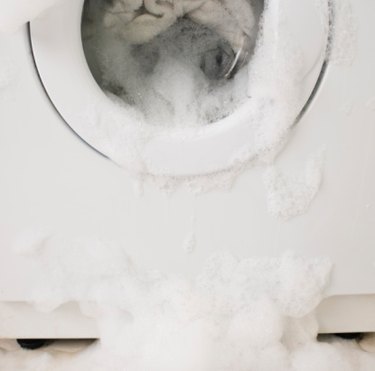
You hear the sound and freeze, just as a stream of soapy water drifts across your floor. You suspect the worst and find it: an overflowing washing machine that's dumping a flood in its wake. Once the damage is done, feel free to yell, scream and slam a few doors — or you can take a more sensible approach and eat a carton of ice cream. Your frustration sated, clean up, fix the problem and invest in a system that will make the clean-up job a breeze, should the flood happen again.
Pull the Plug on the Patient
Video of the Day
Pull the plug and turn off the water at both valves to stop the machine motion that could be at the root of your overflow and flood problem. In all likelihood, a valve that stayed stuck when it should have closed or some element within the fill system control malfunctioned and caused the flooding, but right now, your objective is to clean up the mess as quickly as possible.
Video of the Day
Remove Clothing From the Washer
Pull out individual garments and household linens one at a time, wringing each one forcefully into an adjacent sink to remove as much water as possible before moving on to the next item. Empty the entire tub of its contents. If there's no adjacent sink to hold the soaked garments and linens, grab a large plastic storage tub — the type of container used to stow off-season clothing — and use it to hold the wet clothing until the machine is fixed.
Bail Out the Washer Tub
This could get laborious if you don't own a shop vac: drain the washer tub, and then turn your attention to the floor to begin to vacuum up the flood waters. Once the majority of the water has been sucked up, pull out the unit and check the piping that contains the hoses and then the hoses themselves. If they're old, cracked or blocked from years of vibration, you may only have to replace them to repair the unit. Ask a hardware store clerk for hoses able to withstand 1,400 psi, greater than the standard water pressure found in a home.
Wash and Dry the Floors
Wash the floors with a disinfectant cleanser and/or some bleach. If you can get your hands on a commercial floor sanitizer or a product made just for flood cleanup, it's worth the extra cash you'll spend. Use industrial-size fans to dry up the flood, and open doors and windows and otherwise ventilate the area. Water that seeps beneath carpet, tile or other floor coverings can wick up and stick around long enough to start a nice colony of mildew and/or mold if you don't thoroughly dry out the flood site.
Call in the Cavalry
Have your washing machine repaired by a professional to avert the next flood. If the repair costs seem excessive and the machine is old, consider purchasing a new machine. Regardless of the decision you make, you may wish to consider new products on the market made to simplify flood cleanup, should it happen again.